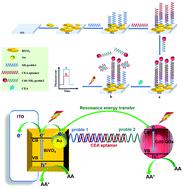Our official English website, www.x-mol.net, welcomes your feedback! (Note: you will need to create a separate account there.)
A sandwich-type photoelectrochemical aptasensor using Au/BiVO4 and CdS quantum dots for carcinoembryonic antigen assay
Analyst ( IF 4.2 ) Pub Date : 2021-08-09 , DOI: 10.1039/d1an01053k Nan Zhou 1 , Xiaofan Xu 1 , Xi Li 1 , Wengao Yao 1 , Xiaohang He 1 , Yulin Dong 1 , Dan Liu 1, 2 , Xiaosong Hu 1 , Yawei Lin 1 , Zhizhong Xie 1 , Deyu Qu 1 , Chaocan Zhang 3
Analyst ( IF 4.2 ) Pub Date : 2021-08-09 , DOI: 10.1039/d1an01053k Nan Zhou 1 , Xiaofan Xu 1 , Xi Li 1 , Wengao Yao 1 , Xiaohang He 1 , Yulin Dong 1 , Dan Liu 1, 2 , Xiaosong Hu 1 , Yawei Lin 1 , Zhizhong Xie 1 , Deyu Qu 1 , Chaocan Zhang 3
Affiliation

|
A novel sandwich-type photoelectrochemical (PEC) aptasensor for the carcinoembryonic antigen (CEA) assay was fabricated using the CEA aptamer, Au/BiVO4 and CdS quantum dots (CdS QDs). In virtue of the localized surface plasmon resonance effect of Au nanoparticles, Au/BiVO4 showed an effective utilization of visible light and excellent photoactivity, and was employed as the photoanode. After CdS QDs were conjugated to Au/BiVO4 through the sandwich structure based on the hybridization of the CEA aptamer with two partially complementary single-stranded DNA molecules, the photocurrents were further enhanced by a resonance energy transfer between CdS QDs and Au nanoparticles. Meanwhile, the consumption of the photo-induced holes by ascorbic acid could also retard the combination of the electron–hole pairs and cause an increase of the photocurrents. However, the specific recognition of CEA by the CEA aptamer could destroy the sandwich structure and remarkably weaken the photocurrent response. Thus, the quantitative detection of CEA was connected with the decrease of the photocurrent. Benefitting from the above methods for signal enhancement, the PEC aptasensor showed a wide sensing range of 0.0001–10 ng mL−1 and a low detection limit of 0.047 pg mL−1 for CEA detection. The specificity, stability and recoveries of the PEC aptasensor were also excellent. Therefore, the construction of the present PEC aptasensor provides a universal and practical method for sensing other substances.
中文翻译:

使用 Au/BiVO4 和 CdS 量子点的夹心型光电化学适体传感器用于癌胚抗原测定
使用 CEA 适体、Au/BiVO 4和 CdS 量子点 (CdS QD)制造了一种用于癌胚抗原 (CEA) 测定的新型夹心型光电化学 (PEC) 适体传感器。凭借Au纳米粒子的局域表面等离子体共振效应,Au/BiVO 4表现出对可见光的有效利用和优异的光活性,被用作光阳极。CdS QDs 与 Au/BiVO 4共轭后通过基于 CEA 适体与两个部分互补的单链 DNA 分子杂交的夹心结构,CdS QD 和 Au 纳米颗粒之间的共振能量转移进一步增强了光电流。同时,抗坏血酸对光致空穴的消耗也会阻碍电子-空穴对的结合并导致光电流增加。然而,CEA适体对CEA的特异性识别会破坏夹心结构并显着削弱光电流响应。因此,CEA的定量检测与光电流的降低有关。受益于上述信号增强方法,PEC适体传感器表现出0.0001-10 ng mL -1的宽传感范围CEA 检测的低检测限为 0.047 pg mL -1。PEC 适体传感器的特异性、稳定性和回收率也非常出色。因此,本PEC适体传感器的构建为感测其他物质提供了一种通用且实用的方法。
更新日期:2021-09-01
中文翻译:

使用 Au/BiVO4 和 CdS 量子点的夹心型光电化学适体传感器用于癌胚抗原测定
使用 CEA 适体、Au/BiVO 4和 CdS 量子点 (CdS QD)制造了一种用于癌胚抗原 (CEA) 测定的新型夹心型光电化学 (PEC) 适体传感器。凭借Au纳米粒子的局域表面等离子体共振效应,Au/BiVO 4表现出对可见光的有效利用和优异的光活性,被用作光阳极。CdS QDs 与 Au/BiVO 4共轭后通过基于 CEA 适体与两个部分互补的单链 DNA 分子杂交的夹心结构,CdS QD 和 Au 纳米颗粒之间的共振能量转移进一步增强了光电流。同时,抗坏血酸对光致空穴的消耗也会阻碍电子-空穴对的结合并导致光电流增加。然而,CEA适体对CEA的特异性识别会破坏夹心结构并显着削弱光电流响应。因此,CEA的定量检测与光电流的降低有关。受益于上述信号增强方法,PEC适体传感器表现出0.0001-10 ng mL -1的宽传感范围CEA 检测的低检测限为 0.047 pg mL -1。PEC 适体传感器的特异性、稳定性和回收率也非常出色。因此,本PEC适体传感器的构建为感测其他物质提供了一种通用且实用的方法。



























 京公网安备 11010802027423号
京公网安备 11010802027423号